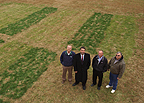October 31, 2006
SIUC weighs best ground cover for campus
CARBONDALE, Ill. -- The grass might be greener on the other side of the fence, but that doesn't mean it's necessarily the best groundcover for the Southern Illinois University Carbondale campus.
Test plots of two grass species grown just south of the Pulliam clock tower showed that while tall fescue maintained its color well into October, zoysia grew in thicker.
"Right now, the zoysia is starting to die back a bit so it's not as green as the fescue, but it's not as brown as the crabgrass either," said Assistant Professor Kenneth L. Diesburg, a turf specialist in the College of Agricultural Sciences' Department of Plant, Soil and Agricultural Systems.
At the request of folks in the Physical Plant, Diesburg along with graduate student Joshua S. Gaebe spent a year assessing the virtues of tall fescue and zoysia to see which could best provide a thick, uniform, low-maintenance turf for the University's many green spaces.
"It's all part of the Southern at 150 plan to improve the beauty of the campus," Diesburg said.
Diesburg and Gaebe compared zoysia grown from seed to zoysia planted in "plugs," to see whether planting method affected how well it took hold. And because the college has a new worm-powered composting building, the two researchers decided to compare the effects on the grass of compost churned out by the worms with those from fertilizer bought by the bag.
Sowing seed worked best for both zoysia and fescue.
"The plots with the plugs are mottled with crab grass," Diesburg said.
"It will take a year or two before they get to where the seeded varieties are right now."
Unlike zoysia, seeded fescue needed help from both commercial fertilizer and compost, making it somewhat more expensive. Zoysia that got a dose of worm compost did a little better than zoysia that went without, but the difference was so small that groundskeepers do without fertilizing unless a planting site has lost all its topsoil.
Diesburg reported the findings to Plant and Service Operations Director Philip S. Gatton, Superintendent of Maintenance and Grounds L. Scott Pike and Grounds Foreman Dennis R. Kiehna in late October. They're now working together to put in some new zoysia strips along the east edge of campus abutting U.S. 51 from roughly Quigley to Anthony halls.
"The high priority areas are the most visible ones, and right now, that one is not pretty." Diesburg said.
Developing a comprehensive, multiphase plan to improve and maintain the campus grounds is among the goals of Southern at 150: Building Excellence Through Commitment, the blueprint the University is following as it approaches is 150th anniversary in 2019.

The plot thickens — Test plots
of grass grown on Southern
Illinois University Carbondale’s
campus show that while tall
fescue is greener, zoysia
fills in better. Grounds L.
Scott Pike(left) planted the
plots and collected the data
for Plant and Service Operations
Director Philip Gatton (in
overcoat). Grounds foreman
Dennis R. Kiehna and
Superintendent of Maintenance
and Turf specialist Kenneth
L. Diesburg (in sunglasses)
will oversee zoysia plantings
on campus green spaces.
Download Photo Here
